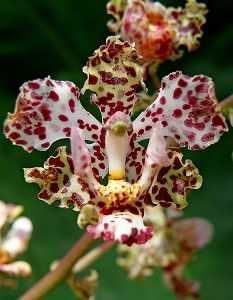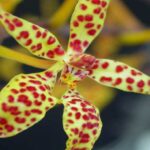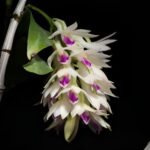Cyrtopodium orchids form a genus of orchids with 48 currently accepted species.
They were proposed in the year 1813 by Robert Brown (1773 – 1858), a Scottish botanist and physicist, famous for his discoveries.
Published in the book Hortus Kewensis, this genus is composed of epiphytic, lithophytic, and terrestrial species.
Cyrtopodium orchids are found in the Americas, mainly in the following locations:
- State of Florida (USA)
- Mexico
- Brazil
- Argentina
To learn more about their characteristics, curiosities, and also some tips for cultivating these orchids, keep reading.
Learn How to Achieve Super Blooms on Your Orchids
🛑 If you love orchids and you're tired of not being able to make them bloom...
Then, know that thousands of beginner growers are achieving beautiful flowers on their orchids by following this method.
Click the button below to have beautiful orchids with show-worthy flowers every year. ⤵
Characteristics

These orchids vary greatly in size, but most of the time they are medium-sized or large.
They have very close and thick pseudobulbs, in other cases tall and thinner.
As for their leaves, while in some species they are no wider than 1cm (0,39 inch), in other cases they can be over 10cm (3,9 inches) wide.
Regarding their flowering, to know if it will bloom, the following rules can help:
- The shoot appeared alone: then it will not bloom
- The shoot appeared along with the floral stem: the cyrtopodium will bloom
Their flowers can be considered small, but they appear in large numbers.
As for their colors, they are usually yellow with small red spots.
Curiosities
Despite not being so famous among cultivators, cyrtopodium orchids have some very interesting curiosities.
One of them is related to their name.
- Cyrto comes from kyrtos and means inclined
- Podium means foot
This is a reference to the inclination of their flowers’ column.
Also, they are also popularly known by various names here in Brazil, some famous ones are:
- Sumaré (RJ and SP)
- Rabo de tatu (Northeast)
- Cola de sapateiro (Goiás)
These are some of the rare orchids that are used for purposes other than decoration.
With cyrtopodium, ointments are made that are used for healing and stopping bleeding.
And lastly, again a curiosity about the names of these plants.
Did you know that most of the species in this genus have a name related to 3 things:
- Name of some family
- Place where it was first found
- Some characteristic of the orchid
See some examples:
- Cyrtopodium Andersonii (tribute to Anderson)
- Cyrtopodium Roraimense (tribute to Roraima)
- Cyrtopodium Gigas (named in relation to the size of the plant)
Now that you’ve learned about the main characteristics of this orchid, let’s find out a little more about how to cultivate it.
How to Care for the Cyrtopodium Orchid

Although not so collected or admired by orchid enthusiasts, this orchid can reward you with beautiful blooms.
This is a very resistant genus, but a little complicated to bloom.
In some species, a decrease in watering during its dormant period is necessary.
To cultivate this orchid, follow the steps below:
1 – Discover its species
As already mentioned, there are terrestrial, epiphytic, and lithophytic species among these orchids, so it is essential that you find out what your type is.
To do this, ask for help from more experienced orchid enthusiasts and try to identify your orchid.
This step is very important for 2 reasons.
- Cultivation varies greatly among these species
- By identifying your orchid, you will find more specific information about its cultivation.
Therefore, at least try to find out if your orchid is terrestrial or epiphytic and where it is native.
NOTE: you will rarely have a lithophytic cyrtopodium.
2 – Provide the ideal cultivation conditions.

Practically all cyrtopodium species need great lighting (direct sunlight most of the day).
Also, you need to ensure intermediate or warmer temperatures.
As for the soil, it will depend a lot on the type of your orchid.
- Epiphytes: provide substrates for epiphytic orchids such as charcoal
- Terrestrial: planting it in the ground with plenty of organic materials is a great option
When choosing the potting mix, make sure it has excellent drainage.
And as for the pots, terracotta pots are highly recommended.
The pot size will vary according to the size of your orchid.
3 – Provide the correct watering.
There are two types of cyrtopodium:
- Those that in their natural habitat go through a dry period
- Those that are in humid places all year round
Cyrtopodium of the first type is the most common and they need some special care to bloom.
First, know that you must offer this dry period during the dormancy of this orchid (usually in May).
During this period, you will not water or water very little, and you will stop fertilizing your orchid.
Some signs that this orchid shows when entering dormancy are:
- Leaf fall
- Drying of some bulbs
- Roots dry out (this shows that they will not absorb water, even if you water)
After this period, buds and maybe flower stalks will appear, so gradually increase the amount of watering.
Regarding cyrtopodium species that do not need a decrease in watering, they usually like higher humidity, so it is important to find out where your species comes from.
Conclusion



Cyrtopodium orchids are very interesting and different plants to have in an orchid collection.
If you are a person with a little more experience in orchid cultivation, this can be a great option to grow.
If you liked this article, you will probably also like these:
- Cooktown Orchid (Dendrobium bigibbum): Care & Curiosities
- Laelia Orchids – History, Curiosities and How to Care
- Ludisia the Jewel Orchid – How to Care in 7 Simple Steps
- Phragmipedium Orchids – How to Care in 7 Steps
Now it’s your turn, leave your comment below and tell us how your orchids are doing.
And if you liked this article, share it on your social networks, because that will help us reach more people.













